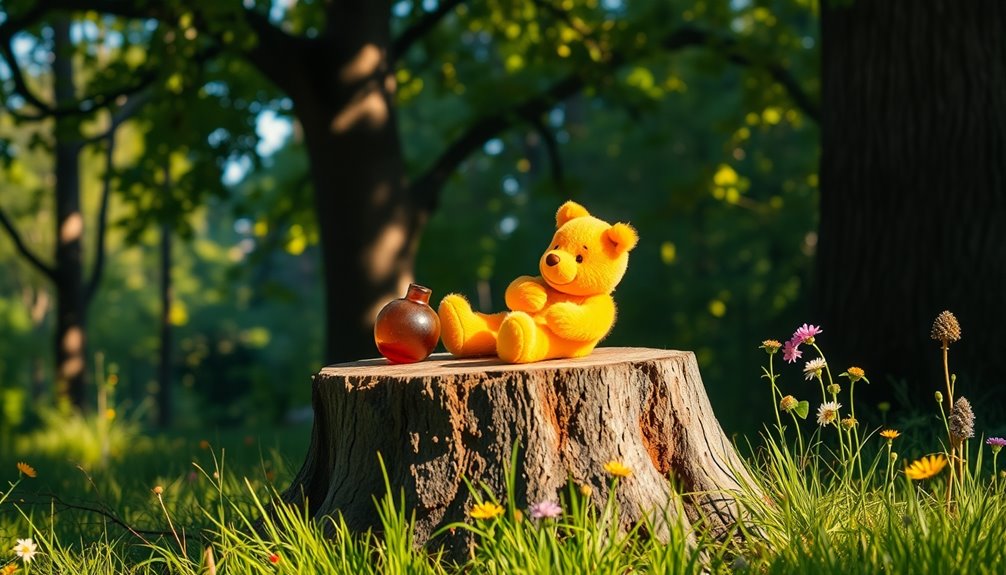In A.A. Milne's "Winnie-the-Pooh," you enter a whimsical world filled with lovable characters like Pooh, Piglet, and Tigger. Set in the enchanting Hundred Acre Wood, these stories revolve around friendship, imagination, and adventures that resonate with both kids and adults. Each character brings unique traits, from Pooh's love for honey to Eeyore's melancholy. The tales are not just fun; they impart lessons about courage, loyalty, and community. Milne's clever writing captivates your heart, making it a timeless classic. If you explore further, you'll uncover even more delightful nuances in this cherished collection.
Overview of Winnie-the-Pooh
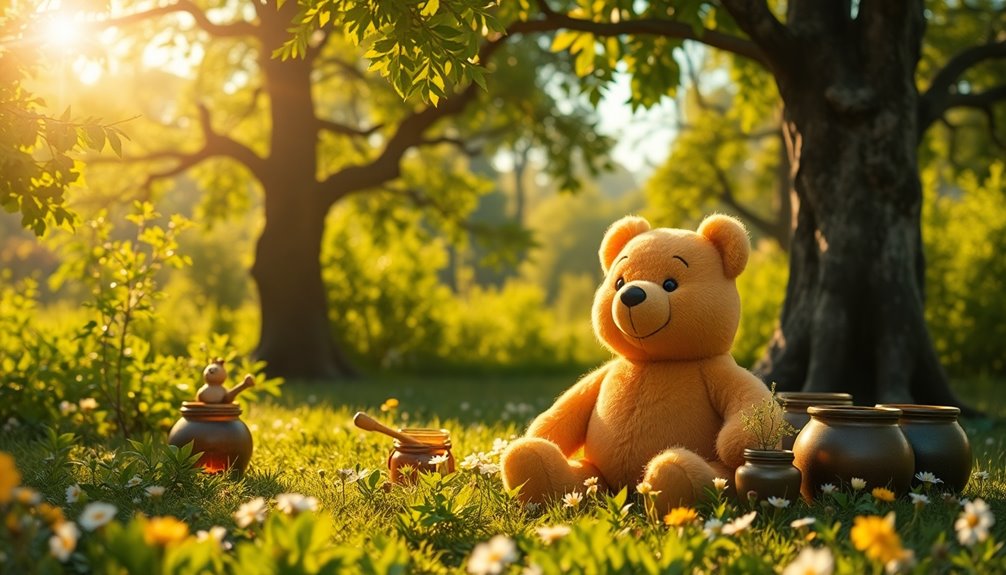
Winnie-the-Pooh, a beloved character in children's literature, invites readers into the enchanting world of the Hundred Acre Wood. In A. A. Milne's charming stories, you follow Pooh and his friends—Piglet, Eeyore, Tigger, and Rabbit—on delightful adventures. Each tale, first published in 1926, captures the essence of childhood innocence and imagination while showcasing the important theme of friendship.
Pooh, often described as "a bear of very little brain," embodies a simple yet lovable personality, primarily driven by his insatiable love for honey. The diverse cast of characters adds depth to the narrative, with each one reflecting different human emotions and experiences. For instance, Piglet's timid nature contrasts with Tigger's exuberance, creating a rich tapestry of interactions that resonate with readers of all ages. The stories also echo the importance of overlooked contributions from various individuals, reminding us that every character, no matter how small, plays a significant role in the larger narrative of friendship and community. These adventures also highlight themes of courage and loyalty that are essential in fantasy narratives.
Accompanied by E. H. Shepard's enchanting illustrations, "Winnie-the-Pooh" has been translated into over 50 languages, ensuring its status as a timeless classic. These stories not only entertain but also teach valuable lessons about friendship, making them enduringly relevant as they continue to influence generations of readers around the globe. Additionally, the enduring popularity of these tales parallels the resilience of women in historical narratives, reminding us of the strength found in friendship and community.
Author Background
A. A. Milne's early life in London and his experiences at prestigious schools shaped his writing style and creative vision. His career took off with humorous pieces and plays, but it was his heartwarming tales of Winnie-the-Pooh that truly defined him. Milne's work has left a lasting impact on children's literature, enchanting readers around the world for generations. His contributions are part of a broader legacy that includes influential figures like Carol Shields, whose storytelling prowess has inspired countless writers. Milne's stories resonate with themes of friendship and adventure, similar to those found in the works of Arthur Ransome. Furthermore, Milne's ability to create relatable characters reflects the power of storytelling in connecting with audiences of all ages.
Early Life Influences
Often, the experiences of our childhood shape the stories we tell, and for A.A. Milne, this couldn't be more accurate. Born in 1882 in Kilburn, London, his early life influenced his writing profoundly. Milne's son, Christopher Robin, played a pivotal role in inspiring the beloved characters in the Hundred Acre Wood. The toys and adventures they shared together became the foundation for Winnie-the-Pooh and his friends.
Milne's educational journey at Westminster School and Trinity College honed his writing skills, enabling him to craft humorous pieces that initially gained him recognition as a contributor to Punch magazine. However, it was his shift into children's literature that marked a significant turning point in his career.
By 1926, he published the first Winnie-the-Pooh stories, drawing directly from his own childhood experiences and the innocence he observed in his son. Through these tales, Milne captured the essence of friendship and adventure, themes that resonate with audiences even today.
His legacy endures, with translations of his works reaching over 50 languages, ensuring that the magic of Winnie-the-Pooh continues to enchant children around the world.
Literary Career Highlights
A.A. Milne, born in London on January 18, 1882, initially found success as a humorist and playwright. After attending Westminster School and then Trinity College, Cambridge, he honed his writing skills and developed a unique comedic style.
It wasn't until 1924 that he made a significant mark in children's literature with his first successful work, "When We Were Very Young." This book laid the groundwork for the beloved "Winnie-the-Pooh" series, which first appeared in 1926.
Milne's "Winnie-the-Pooh" stories quickly became a sensation, capturing the hearts of children and adults alike. They've been translated into over 50 languages, including Latin, showcasing their global appeal.
Through these enchanting tales, Milne created characters that resonate with readers of all ages, making his work timeless.
Milne's legacy in children's literature remains influential today. His imaginative stories and memorable characters continue to inspire countless adaptations and merchandise, solidifying his position as a cornerstone of children's storytelling.
The joy and lessons found in "Winnie-the-Pooh" guarantee that Milne's contributions will be cherished for generations to come.
Lasting Impact on Literature
Milne's influence on literature is undeniable, with "Winnie-the-Pooh" remaining a beloved classic for nearly a century. A.A. Milne, born in 1882, crafted a unique world that resonates with both children and adults. His characters, inspired by his son Christopher Robin and a collection of stuffed animals, embody themes of friendship and childhood innocence. This whimsical storytelling has made "Winnie-the-Pooh" a cornerstone of children's literature.
Since its publication in 1926, the book has been translated into over 50 languages, showcasing its global appeal and enduring legacy. Milne's writing style, characterized by profound simplicity, allows readers of all ages to connect deeply with the narrative.
The impact of "Winnie-the-Pooh" extends far beyond the pages of a book; it has influenced countless adaptations, films, and merchandise, solidifying Milne's status as a pivotal figure in the history of children's literature.
Through delightful adventures and relatable characters, Milne's work continues to teach valuable lessons about friendship and imagination. His ability to capture the essence of childhood guarantees that "Winnie-the-Pooh" will remain cherished for generations to come.
Plot Summary
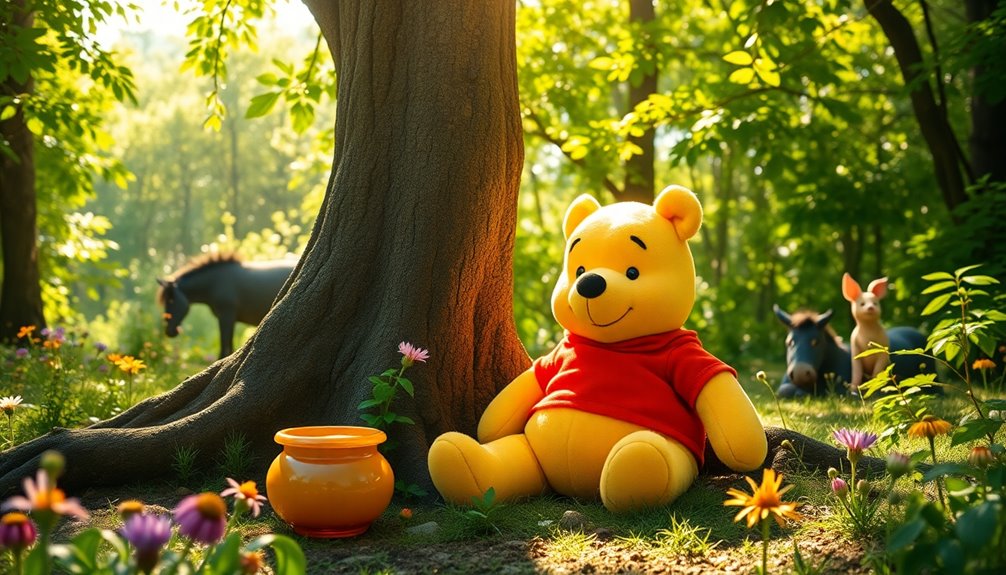
In "Winnie-the-Pooh," readers are invited into the whimsical world of the Hundred Acre Wood, where a lovable bear and his friends commence on delightful adventures. The collection consists of ten charming stories that detail the escapades of Winnie-the-Pooh and his friends, showcasing themes of friendship and imagination.
The journey begins with Pooh's relentless quest for honey, establishing his endearing and honey-obsessed character. As the stories unfold, you'll encounter Piglet, Eeyore, and Rabbit, each presenting unique challenges. For instance, Eeyore's lost tail becomes a mission for the group, while Pooh hilariously finds himself stuck in a doorway, illustrating the lovable mishaps that happen along the way. The essence of character dynamics is beautifully captured as they navigate life's ups and downs together, prompting reflections on the impact of past actions within their relationships.
Throughout these narratives, Milne's whimsical language and clever humor shine, making the tales appealing to both children and adults. Furthermore, the characters' experiences highlight the importance of meaningful connections in personal development, akin to the journeys found in classic tales of healing and growth.
The adventure culminates in a heartwarming celebration for Pooh, reinforcing the importance of friendship and shared experiences among the characters. You'll find that each story not only entertains but also conveys valuable lessons about camaraderie and support, making "Winnie-the-Pooh" a timeless treasure in children's literature.
Key Characters
In "Winnie-the-Pooh," you meet a lovable cast of characters, each with their own unique traits and quirks.
Pooh's simple wisdom contrasts beautifully with the courage of Piglet and the gloominess of Eeyore, creating a rich dynamic among friends. The theme of unity and collaboration is evident as they navigate their adventures together, showcasing the importance of friendship. Their interactions often reflect the complexities of love and betrayal, mirroring the emotional depth found in classic literature.
Tigger's boundless energy adds a lively twist, making their adventures even more memorable. The stories, much like Agatha Christie's intricate plots, captivate readers with their charm and depth.
Pooh and Friends
Winnie-the-Pooh and his friends each bring unique qualities to their adventures in the Hundred Acre Wood. Pooh, the lovable bear with an insatiable appetite for honey, often leads the group with his optimistic and simple-minded approach. His heartwarming innocence shines through as he navigates various escapades, always valuing friendship above all.
Piglet, Pooh's timid sidekick, complements him with his loyalty and courage, despite his small size. Though he often hesitates, Piglet's big heart drives him to join Pooh on many adventures.
Then there's Eeyore, the gloomy donkey whose melancholic outlook adds depth to the group. He frequently loses his tail, which serves as a relatable reminder that everyone has their struggles.
Tigger, the bouncy tiger, bursts onto the scene with his energetic spirit, injecting excitement into their adventures. His playful nature often contrasts with Eeyore's somber demeanor, showcasing the variety of personalities within their circle.
Together, these key characters create a rich tapestry of friendship, laughter, and life lessons, making the Hundred Acre Wood a cherished setting for their heartwarming tales.
Character Dynamics
Character dynamics in the Hundred Acre Wood are both charming and complex, reflecting a delightful blend of personalities. At the heart of it all is Winnie-the-Pooh, a lovable bear with a simple mind and an insatiable love for honey. You often see him starting out on adventures alongside Piglet, his timid yet loyal friend, who, despite his small stature, demonstrates remarkable courage.
Then there's Eeyore, the gloomy donkey whose melancholic outlook adds depth to their tales. He often requires support, especially during his sad moments, like when he loses his tail.
In sharp contrast, Tigger bursts onto the scene with his boundless energy and exuberance, bouncing through life and lifting the spirits of his friends.
Finally, Rabbit plays the role of the planner, ensuring their escapades run smoothly, even if his grumpy demeanor sometimes creates friction. His practical nature sometimes reveals a touch of sociopathic tendencies, especially in his interactions with others.
Together, these characters create a rich tapestry of friendship, adventure, and emotional support, making the Hundred Acre Wood a truly magical place.
Setting of the Hundred Acre Wood

Nestled within the enchanting landscape of the Hundred Acre Wood, you'll find a whimsical world that sparks imagination and adventure. Inspired by the real Ashdown Forest in East Sussex, England, this fictional setting invites you to explore its serene trails and charming landmarks.
As you wander through the wood, you'll encounter iconic spots like Owl's House and the Six Pine Trees, each woven into the delightful tales of Winnie-the-Pooh and his friends. The growth mindset celebrated in personal development literature resonates with the spirit of exploration found in Milne's stories. Here, the importance of creative expression emerges, allowing characters to navigate their adventures with resilience and joy.
The Hundred Acre Wood serves as the perfect backdrop for their adventures, showcasing the innocence of childhood and the joy of friendship. Here, every corner holds the promise of a new escapade, whether it's a search for honey or a gathering with pals.
Although public access to Ashdown Forest is limited, with only two footpaths crossing through the woods, the essence of this tranquil setting shines through in Milne's stories.
As you immerse yourself in the world of Winnie-the-Pooh, you'll appreciate how the Hundred Acre Wood reinforces the importance of community and shared experiences, turning each adventure into a cherished memory among friends. This enchanting environment parallels the resilience found in personal stories of survival, reminding us of the courage that exists in facing life's challenges together.
Themes of Friendship and Imagination
In "Winnie-the-Pooh," you'll see how community support among friends like Pooh, Piglet, and Eeyore makes every adventure more meaningful.
Their imaginative quests spark not just joy but also the spirit of collaboration, showing that tackling challenges together can lead to unforgettable experiences.
The bond they share highlights the importance of friendship in enriching life's journey.
Importance of Community Support
Winnie-the-Pooh and his friends show how important community support is through their adventures in the Hundred Acre Wood. Each character brings unique strengths, making teamwork essential in overcoming challenges. When Eeyore loses his tail, Pooh, Piglet, and the others unite to help him find it, demonstrating their unwavering friendship and commitment to one another.
Their adventures highlight the power of collaboration, as they work together to build a house for Eeyore, showcasing how community support can bring joy and fulfillment. Through these experiences, the characters foster a sense of belonging, proving that caring for each other enhances personal growth.
Milne's narrative emphasizes that imagination flourishes in supportive environments. As Pooh and his friends engage in whimsical adventures, they tap into their collective creativity, illustrating how shared experiences deepen their bonds.
The stories reflect the idea that when friends come together, they can tackle anything life throws their way, reinforcing the value of friendship and teamwork.
In the Hundred Acre Wood, community support isn't just a theme; it's the foundation upon which the characters build their lives, allowing their imaginations to soar.
Adventures Spark Imagination
The adventures in the Hundred Acre Wood ignite the imagination, showcasing the deep bonds of friendship among Pooh and his companions. Each whimsical quest, whether Pooh's honey-seeking missions or Piglet's encounters with Heffalumps, reflects the boundless creativity of childhood. As you read these tales, you can't help but feel the warmth of camaraderie that defines their journeys.
Imagination flourishes in this enchanting woodland setting, where characters like Tigger embody enthusiasm and energy. His playful spirit encourages you to embrace adventure alongside Pooh and friends. The stories weave themes of innocence and wonder, inviting you to rediscover life's simple joys and the magic that friendship brings.
Through each adventure, you witness how the characters support and care for one another, forming a network of resilience and love. Milne's writing beautifully captures the essence of childhood exploration, illustrating how the bonds formed among Pooh and his friends enrich their experiences and create lasting memories.
The Hundred Acre Wood isn't just a backdrop; it's a canvas for imagination, where every corner holds the promise of friendship and adventure waiting to unfold.
Character Dynamics and Interactions
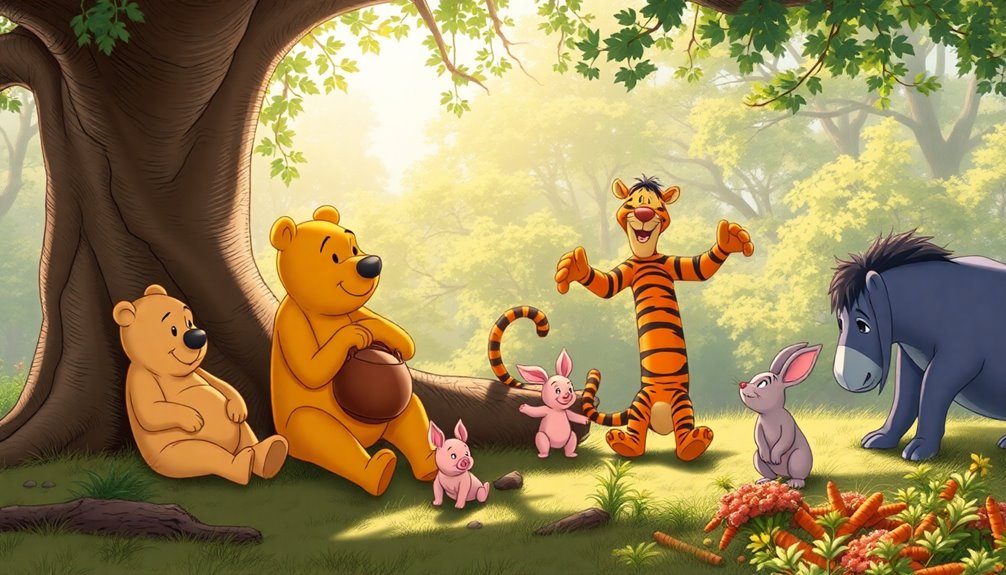
While exploring the enchanting world of the Hundred Acre Wood, you'll quickly notice how the character dynamics among Pooh and his friends create a rich tapestry of relationships.
Winnie-the-Pooh, with his lovable nature and insatiable love for honey, often displays unexpected wisdom and humor, despite his self-proclaimed "little brain." His interactions with Piglet, the timid yet fiercely loyal friend, highlight a bond built on courage. Piglet may be small, but he finds strength when joining Pooh on their charming adventures.
Eeyore, the melancholic donkey, adds depth to their group, often needing his friends' support to combat his gloomy outlook. His interactions with Tigger, the bouncy and energetic character, offer a delightful contrast. Tigger's enthusiasm often lifts the spirits of the group, creating a balance between the various personalities.
Christopher Robin, serving as the nurturing figure, embodies the essence of friendship, guiding Pooh and his friends through their delightful escapades. His presence reinforces their bonds and emphasizes the importance of support and understanding within their dynamic.
Together, these characters create memorable interactions that enrich the tales of the Hundred Acre Wood.
Notable Adventures
Set against the backdrop of the Hundred Acre Wood, Pooh and his friends plunge into a series of memorable adventures that showcase their unique personalities and the strength of their friendships.
In their first escapade, you join Pooh as he sets off on a honey-seeking mission, bravely facing a swarm of bees near a tree. This honey hunt sets the tone for the humorous and lighthearted spirit of their adventures.
Next, you follow Pooh and Piglet as they engage in imaginative play, searching for a Woozle. This whimsical adventure highlights the joy of friendship and the power of creativity.
Meanwhile, Eeyore's missing tail takes center stage when Pooh volunteers to help find it, demonstrating themes of loyalty and teamwork among the group.
Later, you accompany Pooh and his friends on an expedition to the North Pole, where Pooh humorously discovers a mere pole instead of the actual destination.
Their journey culminates in a hero party for Pooh, celebrating their shared experiences and reinforcing the importance of friendship among the characters in these delightful tales.
Adaptations in Media
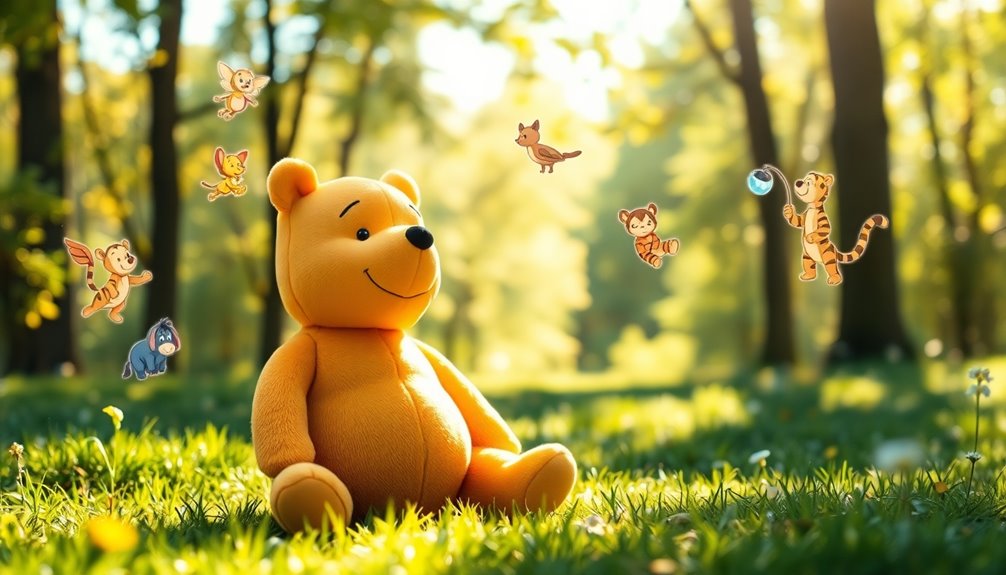
Numerous adaptations of Winnie-the-Pooh have brought these beloved characters to life across various media, enchanting audiences of all ages. The first Disney adaptation, "Winnie the Pooh and the Honey Tree," debuted in 1966, introducing Pooh and friends to a wider audience. This was followed by "Winnie the Pooh and the Blustery Day" in 1968, which won an Academy Award for Best Animated Short Film, showcasing the charm of Milne's children's literature.
Tigger, who first appeared in Milne's sequel "The House at Pooh Corner," has become a standout character in adaptations, particularly in "Winnie the Pooh and Tigger Too" (1974).
The franchise has also expanded into video games, with the Hundred Acre Wood often featured as a playable world filled with interactive minigames.
More recently, "Winnie-the-Pooh: Blood and Honey" (2023) offered a darker twist on these cherished characters, highlighting the versatility of Milne's work across different genres.
From animated films to video games, each adaptation continues to celebrate the timeless adventures of Pooh, Christopher Robin, and friends, ensuring they remain beloved figures in popular culture.
Cultural Impact and Legacy
Celebrating its status as a beloved classic, "Winnie-the-Pooh" has made a significant cultural impact worldwide. Translated into over 50 languages, it reaches diverse audiences and introduces the adventures of Pooh and his friends to children everywhere.
A.A. Milne's original stories have profoundly influenced children's literature, establishing timeless themes of friendship and innocence that resonate with readers of all ages.
The character of Winnie-the-Pooh has inspired numerous adaptations, particularly animated films by Disney, starting with "Winnie the Pooh and the Honey Tree" in 1966. This solidified Pooh's place in popular culture, creating a lasting legacy that extends beyond books.
The franchise generates billions in revenue through various merchandise, including toys, clothing, and home decor, further demonstrating its cultural impact.
Recent adaptations, like "Winnie-the-Pooh: Blood and Honey," showcase the characters' enduring relevance by exploring alternative narratives that reflect changing cultural contexts.
This evolution indicates that Pooh's adventures and the themes of friendship continue to captivate and resonate with new generations, ensuring that the legacy of "Winnie-the-Pooh" remains strong and impactful in today's world.
Community Engagement and Influence
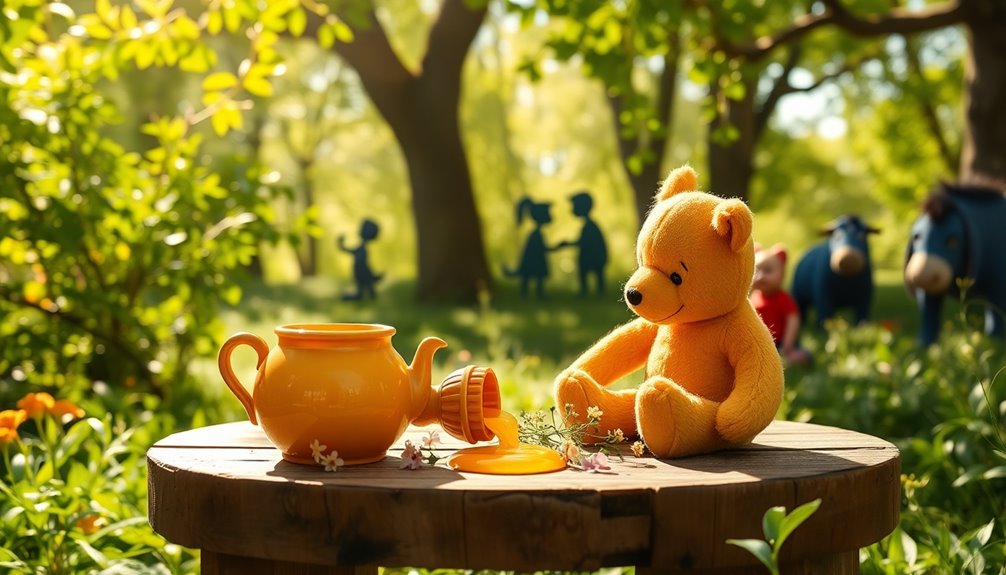
Winnie-the-Pooh's enchanting world fosters a vibrant community of fans who engage with its stories and characters in various ways. This beloved franchise inspires a wealth of merchandise, from toys to clothing, enhancing its cultural presence and encouraging community engagement. Numerous adaptations, including films, TV series, and video games, keep Winnie-the-Pooh relevant, inviting new audiences to join in on the adventures.
The original stories have been translated into over 50 languages, allowing children from diverse backgrounds to connect with themes of friendship and adventure. These universal messages resonate deeply, fostering a collaborative environment where fans share their interpretations and experiences.
Community content, available under CC-BY-SA licensing, promotes sharing and adaptation, further enriching the tapestry of children's literature surrounding Winnie-the-Pooh.
Readers often express emotional connections and nostalgia through community reviews, highlighting the enduring impact of Milne's characters. This engagement not only reinforces the bond between fans but also nurtures creativity, as individuals come together to celebrate their love for Winnie-the-Pooh.
Through these interactions, the legacy of friendship and adventure continues to thrive, making the community surrounding these tales truly special.
Conclusion
In Winnie-the-Pooh, you find simplicity and depth woven together, reminding you that life's sweetest moments often come from the smallest adventures. While Pooh's innocent charm invites laughter, his friendships reveal the profound connections that bind us all. As you close the book, you realize that amidst the chaos of adulthood, there's always room for a little whimsy, urging you to embrace both the joy of play and the wisdom of love in your own journey.

